![]()
 |
Wow!Recent observations have shown the universe to be about 13.7 billion years old!
|
Like early astronomers from around the world, the ancient Greeks struggled to understand the universe. Thales, often called the father of Greek science and mathematics, asked questions about the universe that were not based on the actions of gods or demons. It is said that Thales provided the bridge between the world of myth and the world of reason. He used the astronomical records of the Babylonians and Egyptians to accurately predict a solar eclipse in the sixth century BC. Thales believed the Earth was flat and floated on water like a log.
|
Aristotle, who lived from 384 to 322 BC, believed the Earth was round. He thought Earth was the center of the universe and that the Sun, Moon, planets, and all the fixed stars revolved around it. Aristotle's ideas were widely accepted by the Greeks of his time. The exception, a century later, was Aristarchus, one of the earliest believers in a heliocentric or sun-centered universe. In the 100s BC, Hipparchus, the most important Greek astronomer of his time, calculated the comparative brightness of as many as 1,000 different stars. He also calculated the Moon's distance from the Earth. |

|
The first astronomer to make truly scientific maps of the heavens, Claudius Ptolemaeus (better known as Ptolemy of Alexandria), came along 300 years later. Like most astronomers before him, he believed the Sun, Moon, and other planets circled the Earth. He thought that each space body moved in a small circle (an epicycle) that was itself orbiting Earth. This explained why planets sometimes appeared to travel backward in the sky. The Earth-centered view of the universe was widely accepted for about 1500 years. It was not seriously challenged until 1543, when the Polish monk Nicolaus Copernicus suggested that the Sun was at the center of the universe. Because the Church taught that the Earth was central, Copernicus' theory was regarded as heresy. Perhaps this is why he did not want it published until after his death. Copernicus' published theory, On the Revolution of the Celestial Spheres, met with great hostility from the Church. The two events most responsible for eventual acceptance of Copernicus' views were Tycho Brahe's precise observations of the sky and Galileo's use of the telescope.
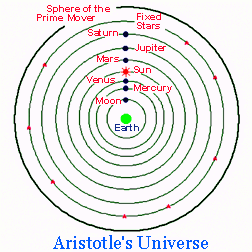 |
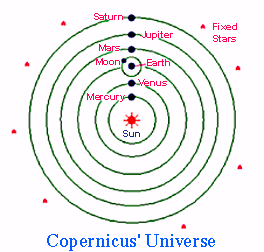
|
One night in 1572, Danish astronomer Tycho Brahe saw what he thought was a brilliant new star in the constellation Cassiopeia. (We now know he was observing a supernova.) In 1604, a second supernova was observed. These discoveries caused scientists to seriously question Ptolemy's theory that all stars were contained in an outermost sphere of the universe that never changed.
In 1609, Italian scientist Galileo Galilei heard about the invention of a spyglass. He made one for himself and turned it on the heavens. One of his first discoveries was of four moons circling the planet Jupiter. Galileo's telescope revealed a miniature version of Copernicus' solar system, with the moons moving around the planet in simple, circular orbits. Galileo's discoveries forever changed the face of astronomy.
The beginnings of modern science can be attributed to Galileo and to the British genius Isaac Newton. Newton was born in the same year that Galileo died. Isaac Newton took known facts and used mathematics to explain them. He developed mathematical laws that explained how objects move on Earth as well as in space. Newton explained the movement of orbiting planets as the result of motion along a straight line combined with the gravitational pull of the Sun. His laws are all based on the idea that nothing is naturally at rest. He reasoned that all heavenly bodies are constantly moving, with no limits on space and time.
In 1917, Albert Einstein proposed a description of the universe based on his Theory of General Relativity. Einstein's theory inspired many other scientists, including Willem de Sitter in Holland and Alexandr Friedmann in Russia. In fact, much of today's cosmology is based on Freedman's solutions to the mathematical equations included in Einstein's Theory. Friedmann built on the General Relativity equations to develop models that helped explain the evolution of the universe.
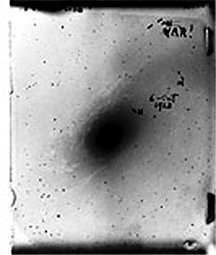 |
A major breakthrough in our understanding of the universe took place in the 1920's thanks to American astronomer Edwin Hubble. For centuries, astronomers believed that the Milky Way made up the entire universe. Hubble was among the first to show that the fuzzy patches in the sky seen through telescopes were other galaxies, not distant parts of the Milky Way. By looking at the spectra of these galaxies, he concluded they were speeding away from us - that the universe was expanding! |
Georges Lemaitre, a Belgian astrophysicist and Catholic priest, came to be known as the "Father of the Big Bang". Lemaitre proposed that the universe began as a single primordial atom of energy, something hot and dense that exploded, causing space to expand outward. In the late 1940s, George Gamow, a Russian-American physicist, conceived of the Big Bang theory as we know it today. He and his colleagues proposed that if a big bang had occurred, it would have left an afterglow, traces of background radiation that would still be present. |
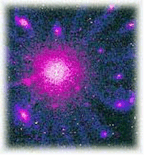 |
In 1965, physicists Arno Penzias and Robert Wilson started to search for faint radio signals (actually microwaves) from the outskirts of the Milky Way Galaxy. While conducting their investigations, they actually found the afterglow predicted by Gamow. It was important evidence that the universe began with a hot big bang. More recently, NASA's COBE satellite measured this radiation in great detail. All of the measurements were consistent with the Big Bang theory.
In 1979, particle physicist Alan Guth performed calculations that led to the idea of "cosmic inflation", a brief period of rapid expansion in the early universe. Inflation solves many problems with the simple, original Big Bang. It explains why the universe is so big and so smooth, why at least four different forces act in it today, and where the large amounts of matter that make up the universe came from.
The idea that the universe had a specific beginning did not appeal to all scientists. The Steady State Theory, developed in 1948, concluded the universe had no beginning and no end. This theory describes an expanding universe that stays in perfect balance like a pool kept full to overflowing by a trickle from a faucet. The "faucet" of the universe would be the continuous creation of matter from energy. Arguments against the Steady State Theory include the discovery of background cosmic heat radiation. The fact that the amount of helium observed in the universe exactly fits what was predicted by the Big Bang and the discovery that galaxies were more crowded together in the past further discredit the Steady State theory.
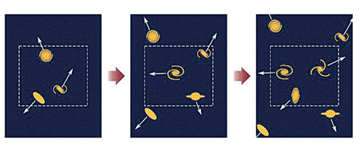
Today cosmologists are concerned with the ultimate fate of the universe. Will it expand forever, expand to a certain size and stop, or will it stop and begin to collapse? Data suggesting that the universe is expanding at an accelerating rate were published in 1998. For more than ten years astronomers studied the expansion of the universe by measuring the redshift and brightness of distant supernovae. By 1998, enough information had been gathered to lead scientists to the startling discovery that the expansion of the universe is not slowing but accelerating. The supernova data combined with information from other cosmological studies strongly suggest that the universe is filled with an unidentified form of energy (currently being called "dark energy" since we know nothing about it) that is causing the expansion of the universe to accelerate. If these observations and analyses turn out to be correct, the universe would be expected to continue to expand forever.
A QuestionHow do the Big Bang and Steady State theories differ in their explanations of how the universe was created? |
|
Did you know? |
The Answer |
![]()
| Show me the Level 1 version of this page. |
The StarChild site is a service of the High Energy Astrophysics Science Archive Research Center (HEASARC), within the Astrophysics Science Division (ASD) at NASA/ GSFC.
StarChild Authors: The StarChild Team
StarChild Graphics & Music: Acknowledgments
StarChild Project Leader: Dr. Laura A.
Whitlock
Curator:
Responsible NASA Official: